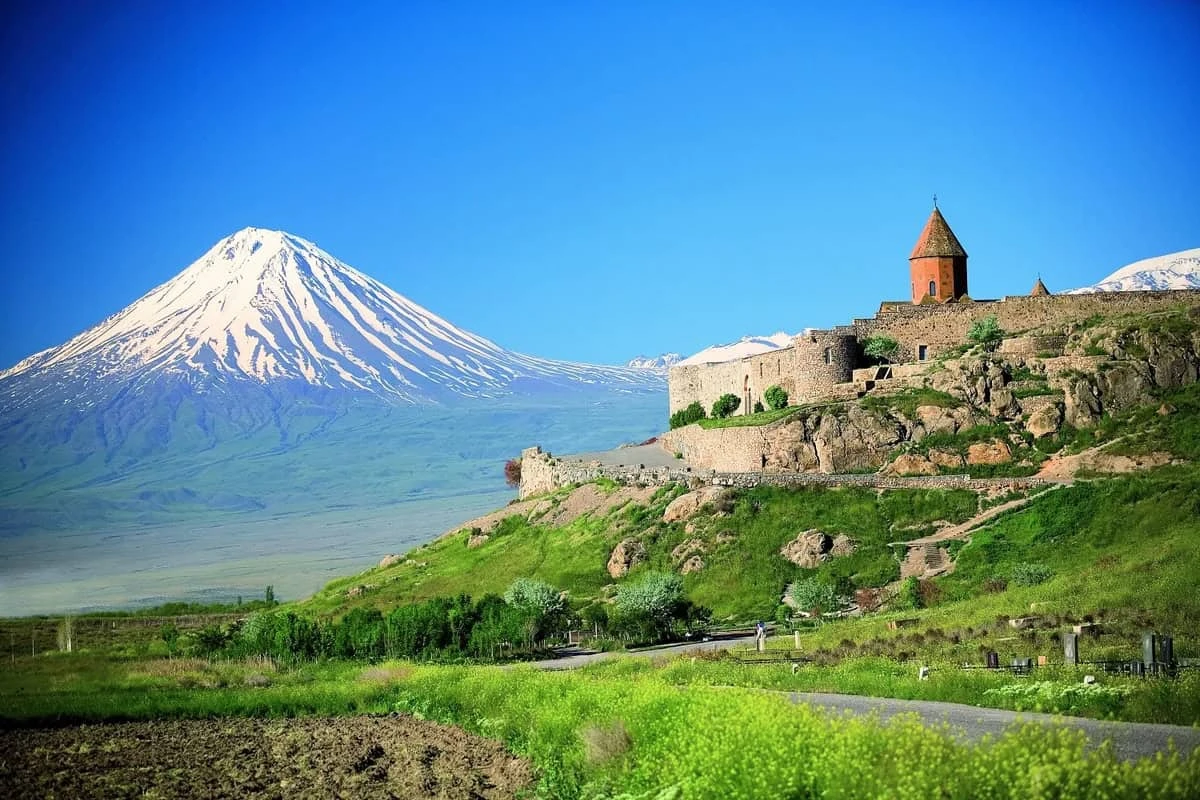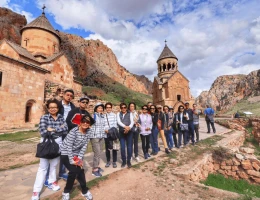Armenia is the first country to officially adopt Christianity (at the beginning of the 4th century), but it is generally believed that Christians appeared here almost immediately after the death of Jesus. Until the year of 1921, the Biblical Mount Ararat was located on the territory of the country: Noah's Ark came to rest here after the Great Flood, and, according to legend, all the inhabitants of Armenia are descended from those who came from the Ark. This is the "Land of churches": monasteries and temples with a thousand-year history have been preserved here. Let's talk about the monastic complexes near the capital which are a must-see.
Khor Virap
The location: on the border with Turkey, near the town of Artashat. The distance from Yerevan to Khor Virap is about 40 km.Interesting aspects: The name is translated from Armenian as "deep dungeon". This is no coincidence: an underground prison has been preserved here to this day, where, according to legend, one of the early adherents of Christianity, Gregory The Illuminator, spent 13 years. He received such punishment for his views from King Trdat III.
13 years later, after the brutal murder of 37 Christian virgins, the king went mad. His sister had a vision that only Gregory could save Trdat. The martyr was released from prison, and he was able to heal the king. Afterwards Trdat got baptized (in 301) and made Christianity the state religion of Armenia, and Gregory himself received the rank of bishop in the year of 303.
Historical reference: In the 5th century, a chapel was built around the prison of Gregory The Illuminator, and a little later a monastic complex was built around it. The underground prison is located under the chapel of St. Gregory (built in the year of 1661), it is a pit 6 m deep and 4.5 m wide, to which there leads an almost vertical staircase.

Khor Virap Monastery
Noravank
The location: 85 km from Khor Virap, 120 km from Yerevan, near the village of Areni.Interesting aspects: From the perspective of tourists it is one of the most impressive sights in Armenia. Majestic structures among the red rocks create the impression that you are somewhere on another planet. Well, or in the plot of an oriental fairy tale. Stone steps without railings seem to lead straight to the sky, ancient walls made of large stones keep the secrets of history. Tourists won't even get in the way of discovering Noravank: it is such a unique place that even selfie lovers involuntarily begin to speak in a whisper. On the way back, we recommend stopping by the village of Areni: according to archaeologists, wine has been made here since the Stone Age.
Historical reference: The monastic complex was founded in 1205. The oldest structure on the territory: the ruins of the St. Karapet temple, dates back to about the 9th century. The complex has preserved khachkars, carved steles with the image of a cross, made in the late 13th – early 14th centuries.

Noravank Monastery
Tatev
The location: Tatev Monastery is located in the Syunik region, around 250 km from Yerevan, on a rocky plateau at the edge of the Vorotan Gorge. The road to Tatev is winding and scenic, offering stunning views.For a unique journey, visitors can take the ropeway "Wings of Tatev" – the world's longest reversible aerial tramway – soaring above the gorge.
Interesting aspects: Tatev impresses not only with its setting but also with its architecture. Built from light gray basalt, the monastery blends naturally with the cliffs. Its exterior is modest, without ornate bas-reliefs or frescoes, which highlights the spiritual focus of the place. Surrounded by deep silence and dramatic nature, the monastery inspires reflection and reverence. Tatev is still an active religious site and visitors can explore its churches, halls and enjoy panoramic views of the Vorotan Valley.Historical reference: The monastery was founded in the 9th century and soon became a vital religious and cultural center. In the 14th–15th centuries, it hosted Tatev University, one of the leading educational institutions of medieval Armenia. Today, Tatev remains a powerful symbol of Armenian faith, knowledge and resilience.

Tatev Monastery
Geghard
The location: about 40 km from Yerevan, near the village of Garni.Interesting aspects:
The name translates as "spear". This is a reference to the spear that was thrust into the rib of Jesus, crucified on the cross. According to legend, the Apostle Thaddeus brought this spear to Armenia and after that it was kept in the monastery, and then transferred to the museum-treasury of Echmiadzin.
The founder of Geghard was Gregory The Illuminator. However, after the attack of Arab troops in the 9th century, nothing remained of the first version of the monastery, built in the 4th century near a cave holy spring. The constructions that have reached us date back to the 13th-14th centuries. Some of them were carved into the rock: temples, tombs, as well as churches. In the Avazan temple there is a holy spring, from which the construction of the complex began. The walls are covered with medieval khachkars, carved inscriptions and patterns.
In 2000 Geghard Monastery was included in UNESCO Cultural World Heritage List. On December 7, 2018 UNESCO granted the status of "objects of enhanced protection" to the Armenian monastery of Geghard and the Upper Azat Valley.
Historical reference: Period of foundation: 4th century, the main building was constructed in 1215. Note the red inscriptions on the walls: a special paint made from the red scale insect, vordan karmir (Ararat cochineal), was used for them. The color has been preserved for already 800 years.

Geghard Monastery
Mother Cathedral of Echmiadzin
The location: 20 km from Yerevan, in the city of Vagharshapat, better known as Echmiadzin.Interesting aspects: The entire city of Vagharshapat is the spiritual center of Armenia, it is compared to the Vatican.
The complex of the Mother See of Holy Echmiadzin is the administrative center of the Armenian Apostolic Church, here is the throne of the Supreme Patriarch. The complex occupies a large territory, about 35 hectares, here is the Echmiadzin Cathedral (founded by Gregory The Illuminator in 301), seminaries and "Treasures of Echmiadzin" museum of Holy Echmiadzin, built by the married couple Alex and Marie Manoogian.
We would like to focus separately on the museum. The most famous church relics are collected here. For example, the Holy Geghard (the spear that gave the name to Geghard monastery), it is the Armenian that corresponds to the dates of the life of Jesus Christ. Here you can also see a piece of Noah's Ark and even a piece of the wooden cross to which Christ was nailed.Mother Cathedral of Echmiadzin is included in UNESCO World Cultural Heritage List.
Historical reference: Date of foundation: 301. New constructions and structures were erected throughout the entire period up until the 21st century. One of the newest is the Church of the Holy Archangels (2009-2011).

Mother Cathedral of Echmiadzin
Sevanavank
The location: approximately 70 km from Yerevan, on the shore of Lake Sevan.Interesting aspects: Immediately after its construction, the monastery was located on an island – to reach it, one had to cover approximately 3 km by water. Now it is a peninsula, however the road cannot be called an easy one. A staircase of 200 steps leads to the monastery, locals believe that these are necessary difficulties that confirm the faith of everyone who comes here. The complex itself stands apart from other Armenian church constructions: the walls of the structures are made of black tuff, which has become even darker over the centuries. There are no bas-reliefs and frescoes on the outside, which further emphasizes the antiquity of the buildings: one wants to forget about the mundane and open his/her heart to higher powers. Currently Sevanavank monastery remains a functioning site. Visit the surviving churches, and then admire the stunning views of Lake Sevan.
Historical reference: Year of foundation: 305. At that time, two churches were built on the site of the pagan temple by Gregory The Illuminator. In the 9th century, the Armenian princess Mariam founded a monastery here.

Sevanavank Monastery
Haghartsin
The location: approximately 100 km from Yerevan, in the Dilijan National Park.Interesting aspects: It is called the Armenian place of power. The monastery Haghartsin is lost in the mountain forests, the territory is very well-kept, the churches remain functioning sites. The structure is dense, it seems that you appeared in a medieval town. Due to the location, there is complete silence here, which can only be broken by the exclamations of tourists. There is a legend that the local tree, or rather its remains after a fire, fulfills wishes: all it takes is to crawl through a gap in the trunk. And if you want to observe the local beauty, you can walk from the monastery along a forest path to the "Hidden waterfall".
Historical reference: Period of foundation: 9th century. The main church, Saint Astvatsatsin, was built at the end of the 13th century.

Haghartsin Monastery complex
Hovhannavank
The location: 21 km from Yerevan, near the village of Ohanavan.Interesting aspects: It is one of the most significant places for Armenian Christians. Its oldest building, the St. Gregory Basilica, was, according to legend, founded by Gregory The Illuminator on the site of a pagan temple. Its incredibly venerable age is indicated by the ground of the latter: paths have been trodden in the stone slabs by parishioners. The altar contains particles of the relics of John the Baptist. The fortifications around the monastery are lined with cyclopean masonry of stone boulders, which also speaks of their antiquity: most often, such buildings were made in the Bronze Age (35 / 33 - 13 / 11 centuries BC).
The main construction was carried out in the 13th century. The main temple of St. Karapet was rebuilt at the end of the 20th century after the earthquake of 1919. Thanks to the multicolored masonry, it whimsically changes color depending on the lighting. It is richly decorated with ancient bas-reliefs and khachkars.
Historical reference: Period of foundation: 4th century, the St. Gregory basilica was completed in the 5th century. The main temple St. Karapet was built in 1216-1221, restored in 1970-1990. For lovers of antiquity, we recommend visiting the village of Ohanavan, where the ruins of a church of cyclopean masonry, built before our era, have been preserved.

Hovhannavank Monastery
All of these monasteries can be reached from Yerevan by private transport or by excursion buses. They are open for visitors year-round – and every time, they look different. The churches and monasteries here preserve the memory of ancient saints, there is no expensive decoration, strict rules for visiting (for example, it is not obligatory for women to wear a headscarf): you have come to God, and He does not care how you look like, what is important is your faith. Perhaps that is why sincere prayers made here are more often heard and fulfilled.












